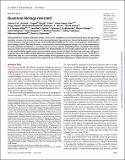Quantum biology revisited
Author(s)
Cao, Jianshu; Cogdell, Richard J.; Coker, David F.; Duan, Hong-Guang; Hauer, Jürgen; Kleinekathöfer, Ulrich; Jansen, Thomas L. C.; Mančal, Tomáš; Miller, R. J. Dwayne; Ogilvie, Jennifer P.; Prokhorenko, Valentyn I.; Renger, Thomas; Tan, Howe-Siang; Tempelaar, Roel; Thorwart, Michael; Thyrhaug, Erling; Westenhoff, Sebastian; Zigmantas, Donatas; ... Show more Show less
DownloadPublished version (1.250Mb)
Publisher with Creative Commons License
Publisher with Creative Commons License
Creative Commons Attribution
Terms of use
Metadata
Show full item recordAbstract
Photosynthesis is a highly optimized process from which valuable lessons can be learned about the operating principles in nature. Its primary steps involve energy transport operating near theoretical quantum limits in efficiency. Recently, extensive research was motivated by the hypothesis that nature used quantum coherences to direct energy transfer. This body of work, a cornerstone for the field of quantum biology, rests on the interpretation of small-amplitude oscillations in two-dimensional electronic spectra of photosynthetic complexes. This Review discusses recent work reexamining these claims and demonstrates that interexciton coherences are too short lived to have any functional significance in photosynthetic energy transfer. Instead, the observed long-lived coherences originate from impulsively excited vibrations, generally observed in femtosecond spectroscopy. These efforts, collectively, lead to a more detailed understanding of the quantum aspects of dissipation. Nature, rather than trying to avoid dissipation, exploits it via engineering of exciton-bath interaction to create efficient energy flow.
Date issued
2020-04Department
Massachusetts Institute of Technology. Department of ChemistryJournal
Science Advances
Publisher
American Association for the Advancement of Science (AAAS)
Citation
Cao, Jianshu et al. "Quantum biology revisited." Science Advances 6, 14 (April 2020): eaaz4888 © 2020 The Authors
Version: Final published version
ISSN
2375-2548